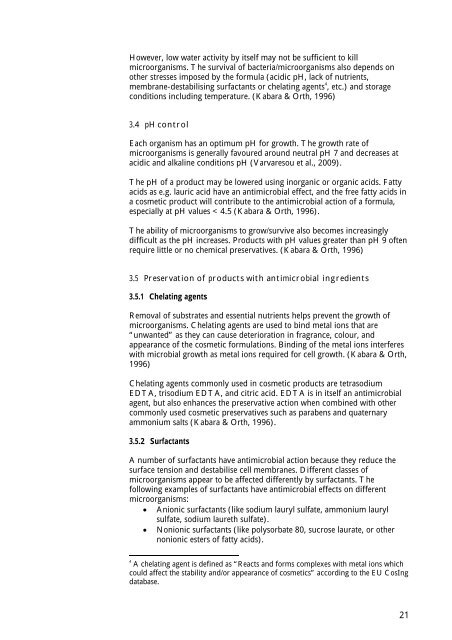Survey and health assessment of cosmetic products ... - Miljøstyrelsen
Survey and health assessment of cosmetic products ... - Miljøstyrelsen
Survey and health assessment of cosmetic products ... - Miljøstyrelsen
Create successful ePaper yourself
Turn your PDF publications into a flip-book with our unique Google optimized e-Paper software.
However, low water activity by itself may not be sufficient to kill<br />
microorganisms. The survival <strong>of</strong> bacteria/microorganisms also depends on<br />
other stresses imposed by the formula (acidic pH, lack <strong>of</strong> nutrients,<br />
membrane-destabilising surfactants or chelating agents 4 , etc.) <strong>and</strong> storage<br />
conditions including temperature. (Kabara & Orth, 1996)<br />
3.4 pH control<br />
Each organism has an optimum pH for growth. The growth rate <strong>of</strong><br />
microorganisms is generally favoured around neutral pH 7 <strong>and</strong> decreases at<br />
acidic <strong>and</strong> alkaline conditions pH (Varvaresou et al., 2009).<br />
The pH <strong>of</strong> a product may be lowered using inorganic or organic acids. Fatty<br />
acids as e.g. lauric acid have an antimicrobial effect, <strong>and</strong> the free fatty acids in<br />
a <strong>cosmetic</strong> product will contribute to the antimicrobial action <strong>of</strong> a formula,<br />
especially at pH values < 4.5 (Kabara & Orth, 1996).<br />
The ability <strong>of</strong> microorganisms to grow/survive also becomes increasingly<br />
difficult as the pH increases. Products with pH values greater than pH 9 <strong>of</strong>ten<br />
require little or no chemical preservatives. (Kabara & Orth, 1996)<br />
3.5 Preservation <strong>of</strong> <strong>products</strong> with antimicrobial ingredients<br />
3.5.1 Chelating agents<br />
Removal <strong>of</strong> substrates <strong>and</strong> essential nutrients helps prevent the growth <strong>of</strong><br />
microorganisms. Chelating agents are used to bind metal ions that are<br />
“unwanted” as they can cause deterioration in fragrance, colour, <strong>and</strong><br />
appearance <strong>of</strong> the <strong>cosmetic</strong> formulations. Binding <strong>of</strong> the metal ions interferes<br />
with microbial growth as metal ions required for cell growth. (Kabara & Orth,<br />
1996)<br />
Chelating agents commonly used in <strong>cosmetic</strong> <strong>products</strong> are tetrasodium<br />
EDTA, trisodium EDTA, <strong>and</strong> citric acid. EDTA is in itself an antimicrobial<br />
agent, but also enhances the preservative action when combined with other<br />
commonly used <strong>cosmetic</strong> preservatives such as parabens <strong>and</strong> quaternary<br />
ammonium salts (Kabara & Orth, 1996).<br />
3.5.2 Surfactants<br />
A number <strong>of</strong> surfactants have antimicrobial action because they reduce the<br />
surface tension <strong>and</strong> destabilise cell membranes. Different classes <strong>of</strong><br />
microorganisms appear to be affected differently by surfactants. The<br />
following examples <strong>of</strong> surfactants have antimicrobial effects on different<br />
microorganisms:<br />
� Anionic surfactants (like sodium lauryl sulfate, ammonium lauryl<br />
sulfate, sodium laureth sulfate).<br />
� Nonionic surfactants (like polysorbate 80, sucrose laurate, or other<br />
nonionic esters <strong>of</strong> fatty acids).<br />
4<br />
A chelating agent is defined as “Reacts <strong>and</strong> forms complexes with metal ions which<br />
could affect the stability <strong>and</strong>/or appearance <strong>of</strong> <strong>cosmetic</strong>s” according to the EU CosIng<br />
database.<br />
21

















